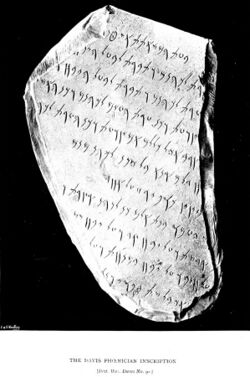Social:Carthage Tariff
From HandWiki
Short description: Punic inscription in Tunisia
| Carthage Tariff | |
|---|---|
 As shown in Cooke's Text-book of North-Semitic Inscriptions | |
| Material | Limestone |
| Created | c. 300 BC |
| Discovered | 1856-58 Tunis, Tunisia |
| Present location | British Museum, London |
| Identification | BM 125303 |
| Language | Punic |
The Carthage Tariff is a Punic language inscription from the third century BCE, found on a fragments of a limestone stela in 1856-58 at Carthage in Tunisia. It is thought to be related to the Marseille Tariff, found two decades earlier.[1]
It was first published by Nathan Davis, and the 11-line inscription is known as KAI 74 and CIS I 167.
The plaque lists the payments for ritual sacrifices, including which portions go to the priests and which to the offerer. It is thought to have been placed on a temple wall, setting out the rules for those giving offerings.
It is held in the archives of the British Museum, as BM 125303.[2]
Gallery
See also
- Palmyra Tariff
- Marseille Tariff
References
- ↑ George Albert Cooke, 1903: Template:IA
- ↑ "Plaque | British Museum". https://www.britishmuseum.org/collection/object/W_1860-1002-18.
 |




